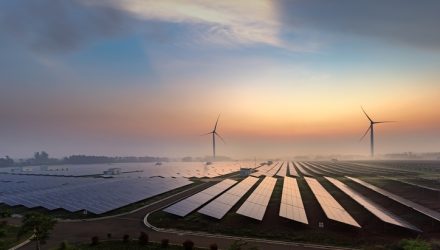Due to the dislocation caused to coal and other fossil fuels by renewable energy sources, a case can be made that any of the related investment ideas are disruptive in nature. Those looking for credible disruption among alternative energy ETFs should consider the ALPS Clean Energy ETF (ACES).
One of 2019’s best-performing ETFs, ACES follows the CIBC Atlas Clean Energy Index. That benchmark is comprised of U.S. and Canada-based companies that primarily operate in the clean energy sector. Constituents are companies focused on renewables and other clean technologies that enable the evolution of a more sustainable energy sector.
What makes ACES compelling at a time of expected exponential growth for renewable adoption is that the ETF’s methodology enables to touch multiple corners of the clean energy space.
“A BloombergNEF report that counted $282.2 billion in funding for clean energy technologies in 2019, up just 1% from the year before, suggested electric cars, offshore wind farms, and energy storage devices will enjoy the biggest gains,” reports Bloomberg.
Bright Future
ACES’ components provide the products and services that enable the evolution of a more sustainable energy sector. The green energy companies are engaged in renewable energy sources, including solar power, wind power, hydroelectricity, geothermal energy, biomass, biofuels, and tidal/wave energy; clean technologies, including electric vehicles, energy storage, lithium, fuel cell, LED, smart grid, and energy efficiency technologies; and other emerging clean energy activities and technologies.
“Wind power is likely to break new ground, bolstered by a 25% increase in installations on land to 69 gigawatts last year. More turbines in the U.S., China, Sweden, Norway, and Spain will compensate for a slight dip in offshore developments,” according to Bloomberg.
Wind is one of ACES’s largest industry exposures.
ACES is at the right place at the right time. Not only is clean energy consumption increasing, but costs are also decreasing, which in turn bolsters adoption. Additionally, coal production is slumping, adding to the virtuous cycle for alternative energy ETFs.
Related: Solar ETF Is Enjoying a Bright Outlook
There’s good news for the ETF’s energy storage exposure, too.
“Falling costs for renewables is driving up installations and will also boost the energy-storage business this year, according to Logan Goldie-Scot at BNEF in San Francisco. More than $5 billion of renewables-plus-storage deals will be announced this year, the researcher said,” reports Bloomberg.
For more on disruptive technologies, visit our Disruptive Technology Channel.
The opinions and forecasts expressed herein are solely those of Tom Lydon, and may not actually come to pass. Information on this site should not be used or construed as an offer to sell, a solicitation of an offer to buy, or a recommendation for any product.

